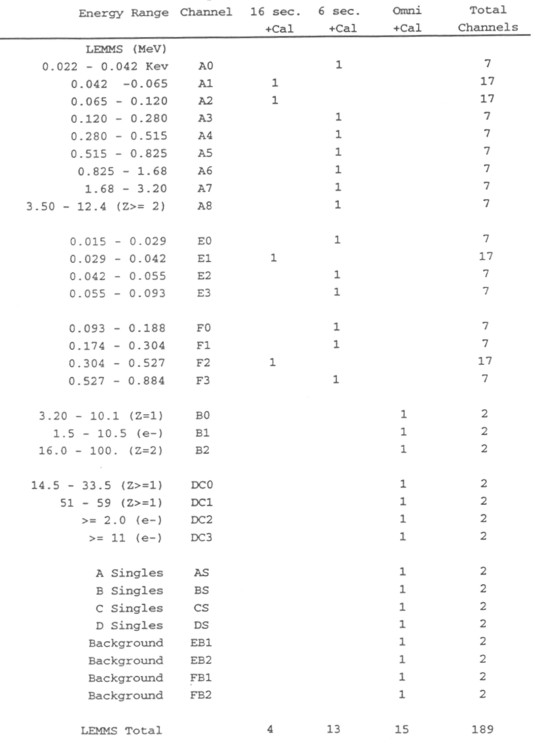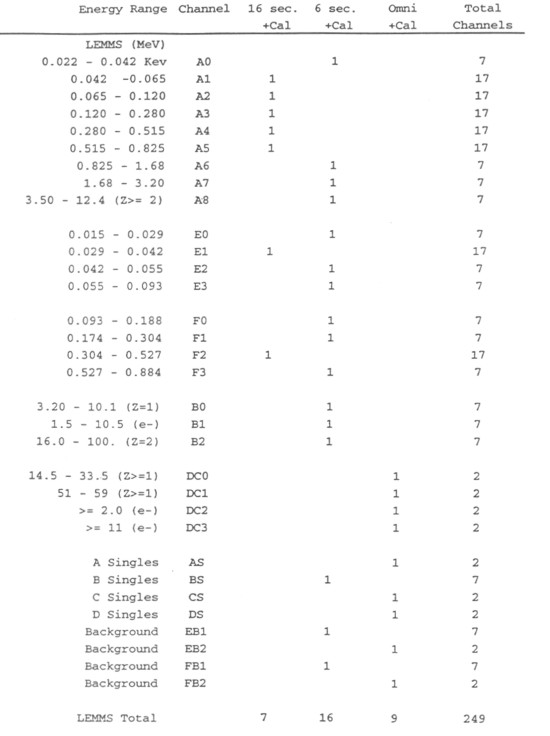The Galileo Energetic Particles Detector
Galileo EPD Handbook
Chapter 2. EPD Software
EPD SBAND Mission Software Requirements (continued)
Source: S. Jaskulek, various dates
Appendix A. Buffer Storage for the EPD Rate Channel Bins
The most straightforward means of storing the rate channel counts in the CDS memory is to use 4 bytes per bin. This allows the 24 bit accumulator data to be directly added into the bin memory using only an add-with-carry instruction. The overflow automatically goes into the fourth, most significant byte. While other approaches are possible which would save CDS memory, they involved greater use of the CDS 1802 processor, and were not used.
When a science record is completed, the CDS must log-compress the contents of each bin and send the results to the telemetry processor. The first accumulator data for the next science record will be received from the EPD approximately 5 seconds after the end of the previous science record. To insure that this processing is completed properly, the CDS will double buffer the binned data.
In addition to the bin array, the results of the log compression computations must be stored and packed (since the results are 9 bit numbers) somewhere. Depending on the buffering scheme used, either a separate result buffer would be needed or the results could be compressed back onto the inactive bin array. These tradeoffs must be made at the CDS level.
The memory required for the Channel Map 1 array can be computed as follows:
| High-res chan.: | {( 4 LEMMS + 6 CMS)*4 bytes}*17 identifiers = 680 |
| Low-res chan.: | {( 13 LEMMS + 9 CMS)*4 bytes}*7 identifiers = 616 |
| Omni-res chan.: | {( 15 LEMMS + 1 CMS)*4 bytes}*2 identifiers = 128 |
| Total |
1424 |
The memory required for the Channel Map 2 array can be computed as follows:
| High-res chan.: | {( 7 LEMMS + 9 CMS)*4 bytes}*17 identifiers = 1088 |
| Low-res chan.: | {( 16 LEMMS + 7 CMS)*4 bytes}*7 identifiers = 644 |
| Omni-res chan.: | {( 9 LEMMS + 0 CMS)*4 bytes}*2 identifiers = 72 |
| Total |
1804 |
Since Channel Map 2 represents the worse case, the bin array memory must be sized for it.
To calculate the amount of CDS memory required to store the rate channel bin array, one must determine which assumptions are to be used. The following table is based upon 451 bins (LEMMS and CMS combined).
It should be noted that the EPD bit-rate allocation determines how many bins are needed for storing the EPD rate channel data, and the number of bins translates directly into CDS RAM bin-array size. There is still uncertainty concerning the EPD bit-rate allocation at the time of this release.
Table A-1. CDS Memory Requirements for EPD Rate Channel Bin Array (451 bins)
| Bytes/bin | Log-compr. & readout method | Bin array size required (bytes) |
| 4 | Compute within 5 seconds | 1804 |
| 4 | Double buffer | 3608 |
| 4 | Drop spin | 1804 |
| 4 | Partially double buffer | 1804 + ? |
| 3 | Compute within 5 seconds | 1353 |
| 3 | Double buffer | 2706 |
| 3 | Drop spin | 1353 |
| 3 | Partially double buffer | 1353 + ? |
Table A2-1. Rate Channel Assignments for EPD LEMMS Sensor Channel Map 1

Table A2-2. Rate Channel Assignments for EPD CMS Sensor Channel Map 1

Table A2-3. Rate Channel Assignments for EPD LEMMS Sensor Channel Map 2

Table A2-4. Rate Channel Assignments for EPD CMS Sensor Channel Map 2

Next: Appendix B. EPD Accumulator Hardware Addresses
Return to Galileo EPD Handbook Table of Contents Page.
Return to main
Galileo Table of Contents Page.
Return to Fundamental
Technologies Home Page.
Updated 8/23/19, Cameron Crane
QUICK FACTS
Mission Duration: Galileo was planned to have a mission duration of around 8 years, but was kept in operation for 13 years, 11 months, and 3 days, until it was destroyed in a controlled impact with Jupiter on September 21, 2003.
Destination: Galileo's destination was Jupiter and its moons, which it orbitted for 7 years, 9 months, and 13 days.



